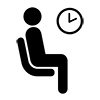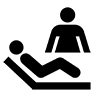Front-line diaries: a life in the day of three emergency department nurses

Nurses from three different emergency departments in England share their diary accounts of a shift shortly before COVID-19’s lockdown restrictions were eased on 19 July
- Emergency nurses’ diaries chronicle prioritising backed-up ambulance patients, juggling beds and maintaining social distancing while triaging
- Presentations include patients with long-COVID symptoms and respiratory illnesses usually seen in winter or in pre-pandemic primary care settings
- Shifts include attending bed meetings remotely and dealing with high level of afternoon walk-ins

As pandemic restrictions eased across the UK on 19 July, emergency nurses report unremitting pressures on their departments and concern about what looms ahead.
Here, three emergency nurses share their diary accounts from July.
Genuinely shocked by the sheer amount of patients presenting

Gayle Wells, senior professional development nurse in the emergency department at Frimley Park Hospital, Surrey
I had one of the most difficult shifts of my career.
Our department was originally built for about 250 patients a day, but during the course of the day, we saw 435 patients. I’m genuinely shocked by the sheer amount of patients presenting at the moment.
These ‘winter’ numbers are a reflection of the changes in primary care since COVID-19, such as a lack of available appointments and people experiencing challenges with long-COVID symptoms.
My morning began leading as the band 7 on the rapid assessment team (RAT) to assess ambulance patients using five cubicles. Then, at lunchtime, I took over the emergency department (ED) as the nurse in charge.
‘I feel uncomfortable, morally and ethically, with ambulances queuing outside as someone out in the community could be waiting for an ambulance. But how can I create room when there isn’t any?’
I had to allocate appropriate staff to all areas, including COVID-19 amber and red pathways in child and adult departments, as well as allocate a small waiting room due to social distancing.

My team in the waiting room had a constant queue of people waiting to get through the front door and it was a juggle to manage the unwell patients with little cubicle space.
From a patient safety perspective, I absolutely love the ethos of RAT – to improve patient safety by timely investigations and early treatment where appropriate. This also assists our ambulance colleagues to get back on the road rather than truck queueing.
I feel uncomfortable, morally and ethically, with ambulances queuing outside as someone out in the community could be waiting for an ambulance. But how can I create room when there isn’t any? When patient flow stops, it has a knock-on effect, and the trucks begin to queue.

During the day, the hospital was struggling for beds and we were having to flip bays to the other gender to make room for the increasing number of admissions. I spent most of my time running from one area to another, creating space and checking that my colleagues and patients were safe.
A full resus area meant I was constantly considering how to make a space if needed. I also had to attend a bed meeting remotely, as well as a board round to manage the stats on internal bed flow decisions.
One challenge was helping a vulnerable adult who had capacity to leave the ED and find a way to get them home safely. This type of task takes time: you learn to multitask and listen to lots of voices at the same time. At one point, I had to assist colleagues who were extricating a patient from a car who hadn’t been able to get an ambulance.
Finally, I handed over and was able to finish my shift at 8.45pm following some safeguarding referrals and a review of the ambulance stats. I was mentally exhausted, but proud of all my colleagues for working above and beyond their roles.
I’ve been a registered nurse for 22 years and am proud to represent the NHS as a small cog in the challenging, large wheel that keeps turning.
Breaks are like dominoes – if one person is late it can be hard to catch-up

Kirstie Maxted, sister in the emergency department at Worcestershire Royal Hospital
6:30am Before COVID-19, arriving just in time for the start of your shift was something all of us did every now and again. These days we’re all in the department with enough time to change into our uniform and shift into ‘work mode’ before we start. As a sister you don’t find out if you’re going to be in charge until you arrive so we make time to allocate roles before the shift begins.
7am We read through the handover: welcomes to new staff; audit results; and another reminder of the importance of wearing the correct personal protective equipment. I’m allocated to resus with one of the senior staff nurses.
7.15am There are two patients in the four-bed resus this morning; a two year old who has had several seizures and a 78 year old with an acute gastrointestinal bleed. Both have been here for several hours and are ready for transfer to the ward. I explain to the child’s parents that the COVID-19 visiting policy only allows one parent to stay. The child’s mother becomes upset and begs me to let her husband stay, too.
9am A new admission – a man with hyperkalaemia.

9:30am We take in our second patient – a 75 year old, who is bleeding from a facial tumour. He looks extremely unwell. We take handover and discover that he has oral cancer and has been experiencing bleeding from his tumour site. Upon assessment he is hypotensive, tachycardic and hypoxic. I triage him while another nurse applies oxygen, monitoring and prepares a fluid bolus. I take venous blood samples while he is assessed by the doctor.
12:30pm As there are still only two patients in resus, I send the other nurse to take her break, the late shift nurse will be here in 30 minutes so I can manage on my own until then. The breaks are like dominoes – if one person is late it can be hard to catch-up and we are short-staffed this afternoon.
1:30pm Time for my break. I eat and then head out to take handover for the afternoon. Numbers are rising: there are now 73 patients in the ED.
2:15pm The nurses in high dependency care haven’t been able to take a break yet, an agency nurse is running late, acuity is high and the area is full. Since the start of the pandemic the high dependency area has been used to care for the most unwell patients with any respiratory symptoms. I arrange for two patients with negative swabs to be stepped down to the main department.

3:30pm The alert phone is ringing. I take two calls, both patients triggering ‘red flag sepsis’. They will go into the two high-care spaces I created earlier. Ambulances are beginning to queue outside and the waiting room is getting busy. One of the senior sisters working in the office this afternoon comes out to help triage. High afternoon walk-in numbers are common these days, a lot of GP referrals and minor injuries, in addition to our usual ambulance surge.
4pm The alert phone is ringing again. This time a patient with suspected COVID-19. My heart sinks, and I push away thoughts of another potential wave of infections. Our numbers have been low recently – at one point there were only five COVID-19 patients in the whole trust and it was starting to feel like we might be coming out of the other side of all this.
4:15pm One of the reception team comes in and asks for some assistance with a fallen patient. A woman who had just returned from X-ray is on the floor – she lost her footing, fell and now has pain in her hip. We use a scoop to lift her onto a trolley with assistance from one of the security staff. She is assessed by a doctor in Majors.
4:50pm When I return to the desk a doctor informs me that there’s another alert. A young man from a road traffic collision with an open tibia-fibula fracture. While we discuss this, the phone rings again – an attempted suicide: the patient has used a ligature and has a Glasgow Coma Scale of 7. I take both alerts to resus and the staff begin to prepare.
6pm I spend the last couple of hours of the shift getting patients moved to wards as beds become available. We’re then able to bring patients in from the ambulances outside.
7pm The night staff are here: I hand the 87 patients in the department over to the nurse in charge.
7:30pm I change out of my uniform. My head hurts and my feet ache. It’s been a challenging day and I’m ready to go. As I leave, I think about the man with possible COVID-19: there is a creeping anxiety about the possibility of numbers of cases rising again.
Despite its difficult days, I love working here and am proud to be a part of the ED family.
I fear this will put nursing staff off emergency medicine as a specialty

Kathleen Shields, trainee advanced clinical practitioner in the children’s emergency department at Royal Manchester Children’s Hospital
7:30am Coming on to the shift I have a sense of trepidation. I’ve been off for the past week and it feels like I’ve forgotten everything. I’m greeted by one of the nursing team from the night shift who offers me a ‘good luck’. I appreciate the humour, but it makes me more apprehensive. What am I walking into?
8am The day team reviews the board, I can see lots of purple, which means many patients have been waiting over four hours. There are no admitting beds and our respiratory area is full of patients with bronchiolitis, viral wheeze, pneumonia and croup. I have to remind myself this is July: the volume of patients, lack of space and type of diagnoses sound like winter illnesses. I am handed over a patient to review, a three year old with breathing difficulties who has already had an inhaler.
8:30am In the respiratory area I realise there is nowhere to assess my patient. Our department is segregated for social distancing. I can already tell the morning will be a day of musical chairs – one in, one out.
‘I see several non-respiratory patients – a two year old with a pulled elbow; an eight year old with a button up their nose; and a five year old with a laceration. It’s refreshing to see children continuing to get up to their usual mischief’
9am Finally, a free cubicle to review my patient who last had their inhaler an hour ago and is still experiencing shortness of breath and wheeze. I prescribe another inhaler and plan to review shortly. I let the nurse in charge know the child will need admission and refer to the children’s medical team. This child will join the queue for those waiting for beds, which is around ten hours.
9:30am The charge nurse is liaising with the children’s medical team about which patients are fit for transfer. Ambulances are booked for several transfers so there might be some light at the end of the tunnel.

11:30am I see several non-respiratory patients – a two year old with a pulled elbow; an eight year old with a button up their nose; and a five year old with a laceration. It’s refreshing to see children continuing to get up to their usual mischief.
12:30pm An update from the charge nurse on ambulance transfers: some patients will still wait for more than 12 hours. Non-acute admissions are cancelled and specialty teams are asked to prioritise safely discharging patients from the hospital. We’re told our patients will now be allocated wards locally. We’ve saved the 12-hour trolley wait, but I worry what this will mean for the rest of the day and night.

1pm I finish all remaining jobs and head for lunch. People are spread across our staff room in line with social distancing rules. Multiple members come in and realise they will have to come back later as there is no space. I feel guilty, but I know that some time to sit down, rest and eat is important.
1:30pm I spend the next few hours assessing patients in the respiratory area again. A first-time mother has brought in her young child with concerns about their breathing and feeding. She says she has tried her GP and couldn’t be seen. On assessment, I decide the child does not need emergency care. I explain how to contact their health visitor, discharge them home and arrange a follow-up review with the children’s community nursing team. While I’m happy to be able to send patients home quickly with a reassurance only, the ED is inappropriate for patients like this.
3:30pm I finish the day with administration work. I feel guilty leaving the department: the pressure continues and it feels like a sinking ship. I’m worried for the night staff, particularly the newer ones. I hope there’s some let up soon and these pressures do not roll on to winter. I fear this will put nursing staff off emergency medicine as a specialty. Thankfully, I can’t see myself working anywhere else.
